African Slender-snouted Crocodile (Mecistops cataphractus*)
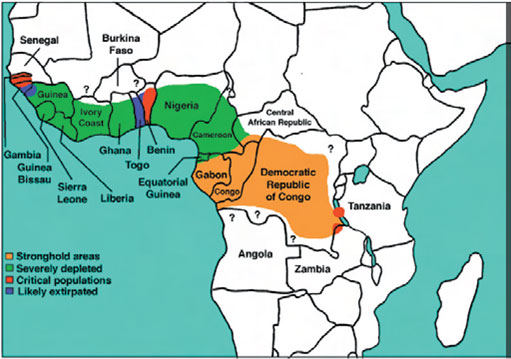
The African Slender-snouted Crocodile has a narrow snout, and closely resembles the Australian Freshwater crocodile (C. johnstoni). The species is restricted to Central and West Africa (Angola, Benin, Burkina Faso, Cameroon, Central African Republic, Chad, Congo, Cote d’Ivoire, Democratic Republic of Congo, Equatorial Guinea, Gabon, Gambia, Ghana, Guinea, Guinea Bissau, Liberia, Mali, Mauritania, Nigeria, Senegal, Sierra Leone, Tanzania, Togo, Zambia) and until recently, was one of the least known crocodilians. They are rarely found in abundance, and the maximum size attained is thought to be about 4 m, with average adult sizes of 2-2.5 m. Although the slender snout suggests fish-eating habits, a variety of other prey such as crustaceans, crabs, insects, frogs and snakes are also taken.
Like the Dwarf Caimans of South America, M. cataphractus nests in rainforest beside small streams and rivers. The dense vegetation canopy prevents direct sunlight reaching the nests, and fermentation of the nest material helps maintain nest temperatures within acceptable limits for survival. Egg-laying (13-27 eggs) takes place in April, and incubation takes 90-100 days. It appears that varanid lizards are predators on the eggs, although the levels of predation are unknown. Hatchlings appear in July, which coincides with the beginning of the wet season.
On the IUCN Red List M. cataphractus is assigned with ‘data deficient’ status. This partly results from its unknown southern range distribution and on the other hand from the insufficient survey data from the supposed stronghold areas in the Congo basin. However, recent surveys suggested persisting localized populations in Ivindo and Ogoué River basins. Investigations within Western distribution countries revealed severely depleted or even extinct populations.
American Crocodile (Crocodylus acutus)
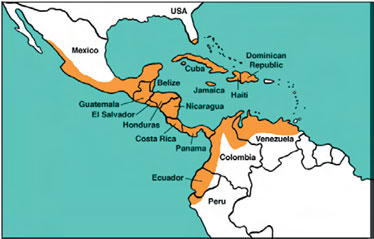 The American Crocodile is another widely distributed species. It extends from a relict population in Florid (USA), through the Caribbean Islands and along the coast of Central America to the northern coast of South America. Throughout much of this range numbers have been greatly reduced, although significant populations still occur in Haiti, the Dominican Republic and Cuba. It occupies coastal habitats such as mangrove swamps and brackish bays, large lakes, and may extend well upstream in coastal rivers. American crocodiles are capable of moving considerable distances, and some individuals that have strayed out of their normal range have been found in the Cayman Islands and Trinidad.
The American Crocodile is another widely distributed species. It extends from a relict population in Florid (USA), through the Caribbean Islands and along the coast of Central America to the northern coast of South America. Throughout much of this range numbers have been greatly reduced, although significant populations still occur in Haiti, the Dominican Republic and Cuba. It occupies coastal habitats such as mangrove swamps and brackish bays, large lakes, and may extend well upstream in coastal rivers. American crocodiles are capable of moving considerable distances, and some individuals that have strayed out of their normal range have been found in the Cayman Islands and Trinidad.
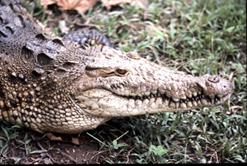 The species is a moderately sized crocodilian that can at times exceed 4 m in length. Females appear to be primarily hole-nesters, although in Florida both hole and mound nests may be used. Females supposedly return to the same nesting site each year, and are thought to reach sexual maturity at about 2.5 m in length.
The species is a moderately sized crocodilian that can at times exceed 4 m in length. Females appear to be primarily hole-nesters, although in Florida both hole and mound nests may be used. Females supposedly return to the same nesting site each year, and are thought to reach sexual maturity at about 2.5 m in length.
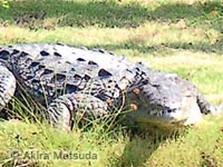
Adults remain in dens near the nests, burrowing up to 9 m into creek banks. Eggs are typically laid in April-May, and hatchlings emerge in July-August. However, timing of nesting does vary geographically. For example, in Colombia, populations in different parts of the country nest at different times of the year, due to climatic differences between the areas. In Florida, predation on eggs and hatchlings by raccoons is significant, and recruitment into the population is low. In other areas of its distribution, numbers have been reduced due to hunting and habitat loss.
Australian Freshwater Crocodile (Crocodylus johnstoni*)
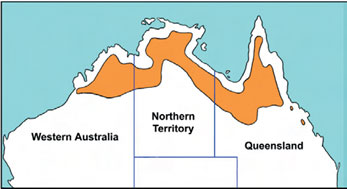 The Australian Freshwater Crocodile or Johnston's River crocodile is endemic to mainland Australia. It is a small species, seldom exceeding 3 m, with a narrow snout resembling that of Tomistoma. The species was hunted for its skin up to the early 1970s, but has now largely recovered from the effects of past hunting. The full impact of introduced cane toads (Bufo marinus) on wild C. johnstoni populations is not known, but adult and juvenile mortalities (as high as 77%) have been reported in areas once the toads arrive. The species is known to be more susceptible to cane toad toxin than the Saltwater Crocodile (C. porosus).
The Australian Freshwater Crocodile or Johnston's River crocodile is endemic to mainland Australia. It is a small species, seldom exceeding 3 m, with a narrow snout resembling that of Tomistoma. The species was hunted for its skin up to the early 1970s, but has now largely recovered from the effects of past hunting. The full impact of introduced cane toads (Bufo marinus) on wild C. johnstoni populations is not known, but adult and juvenile mortalities (as high as 77%) have been reported in areas once the toads arrive. The species is known to be more susceptible to cane toad toxin than the Saltwater Crocodile (C. porosus).
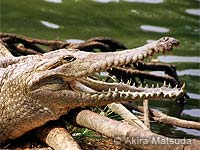 Nesting occurs during the dry season (August-September), with clutch sizes averaging 13 eggs. Eggs are laid in a hole nest dug in friable substrates, and females do not guard their nests/eggs. Hatching occurs in November-December, before wet season rains begin. Prior to colonisation by cane toads, egg mortality was high (<90-95%), mainly the result of predation by goannas (monitor lizards). In one area where data are available, egg mortality has now decreased to <50%, and hatchling recruitment has increased by 400% or more, as goanna numbers were greatly reduced by the arrival of toads.
Nesting occurs during the dry season (August-September), with clutch sizes averaging 13 eggs. Eggs are laid in a hole nest dug in friable substrates, and females do not guard their nests/eggs. Hatching occurs in November-December, before wet season rains begin. Prior to colonisation by cane toads, egg mortality was high (<90-95%), mainly the result of predation by goannas (monitor lizards). In one area where data are available, egg mortality has now decreased to <50%, and hatchling recruitment has increased by 400% or more, as goanna numbers were greatly reduced by the arrival of toads.
Like other crocodilians, individual growth rates vary considerably. During the dry season “freshies” eat little, and annual growth takes place during the wet season when food is more plentiful. Diet consists mainly of fish, although other prey is also taken (eg mammals, reptiles, amphibians, insects). Freshwater crocodiles inhabit a variety of freshwater habitats, and may occur in very high densities in isolated billabongs (pools) during the dry season. In many rivers Australian Freshwater Crocodiles are sympatric with the larger Saltwater Crocodile.
Cuban Crocodile (Crocodylus rhombifer)
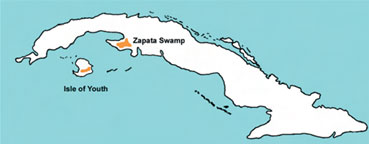 The swamp dwelling Cuban Crocodiles are medium sized, hole nesting animals, which mainly feed on fish, turtles and small mammals. Apart from that only few ecological data are available. The crocodiles are endemic to Cuba, where they are restricted to Zapata Swamp on the mainland, and Lanier Swamp on the Isle of Youth (previously named Isle of Pines). In 1959-60 several hundred adult C. rhombifer were translocated to enclosures within Zapata Swamp, when they were under threat from agricultural development. The development did not go ahead, but the crocodiles remained within the enclosures, where they mixed with Crocodylus acutus. The two species interbreed, and pure-bred C. rhombifer are now outnumbered by hybrids.
The swamp dwelling Cuban Crocodiles are medium sized, hole nesting animals, which mainly feed on fish, turtles and small mammals. Apart from that only few ecological data are available. The crocodiles are endemic to Cuba, where they are restricted to Zapata Swamp on the mainland, and Lanier Swamp on the Isle of Youth (previously named Isle of Pines). In 1959-60 several hundred adult C. rhombifer were translocated to enclosures within Zapata Swamp, when they were under threat from agricultural development. The development did not go ahead, but the crocodiles remained within the enclosures, where they mixed with Crocodylus acutus. The two species interbreed, and pure-bred C. rhombifer are now outnumbered by hybrids.
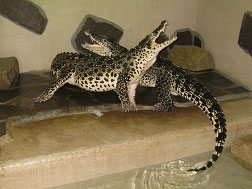 Hybridisation also occurs naturally in the wild population. Some Cuban Crocodiles were transported to Vietnam and later to Cambodia, and hybridisation has occurred with the Siamese crocodile (C. siamensis) in both countries.
Hybridisation also occurs naturally in the wild population. Some Cuban Crocodiles were transported to Vietnam and later to Cambodia, and hybridisation has occurred with the Siamese crocodile (C. siamensis) in both countries.
The population of C. rhombifer on the Isle of Youth may be threatened by the establishment of the introduced caiman, Caiman crocodilus fuscus. Conservation efforts have seen C. rhombifer reintroduced into habitats there.
Dwarf Crocodile (Osteolaemus tetraspis*)
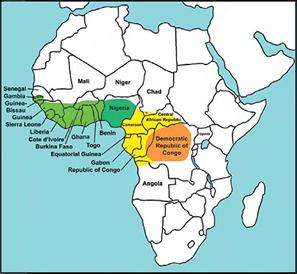 The Dwarf Crocodile is restricted to Central and West Africa (Angola, Benin, Burkina Faso, Cameroon, Central African Republic, Congo, Cote d’Ivoire, Dem. Rep. Congo, Equatorial Guinea, Gabon, Gambia, Ghana, Guinea, Guinea-Bissau, Liberia, Mali, Nigeria, Senegal, Sierra Leone, Togo), and its biology and ecology are very poorly known. It rarely exceeds 2 m in length - average adult size is 1.0-1.5 m. In appearance, it resembles the dwarf caimans of South America, but it is of course in a totally different subfamily.
The Dwarf Crocodile is restricted to Central and West Africa (Angola, Benin, Burkina Faso, Cameroon, Central African Republic, Congo, Cote d’Ivoire, Dem. Rep. Congo, Equatorial Guinea, Gabon, Gambia, Ghana, Guinea, Guinea-Bissau, Liberia, Mali, Nigeria, Senegal, Sierra Leone, Togo), and its biology and ecology are very poorly known. It rarely exceeds 2 m in length - average adult size is 1.0-1.5 m. In appearance, it resembles the dwarf caimans of South America, but it is of course in a totally different subfamily.
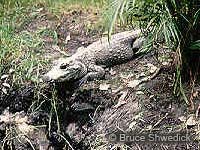
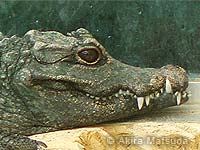 It is a nocturnal species, and is rarely seen during the day. Generally docile and timid in nature, Dwarf Crocodiles do not congregate in large numbers, and are usually solitary. They are associated with tropical rainforests, and tend to avoid large watercourses. Frogs, fish and crabs are the major prey items. In captivity, females lay 11-17 eggs in a mound nest around June-July. Large osteoderms in the skin, nocturnal habits and small size have saved the species from the intense exploitation that Crocodylus niloticus has suffered, though some hunting still occurs, mainly for meat.
It is a nocturnal species, and is rarely seen during the day. Generally docile and timid in nature, Dwarf Crocodiles do not congregate in large numbers, and are usually solitary. They are associated with tropical rainforests, and tend to avoid large watercourses. Frogs, fish and crabs are the major prey items. In captivity, females lay 11-17 eggs in a mound nest around June-July. Large osteoderms in the skin, nocturnal habits and small size have saved the species from the intense exploitation that Crocodylus niloticus has suffered, though some hunting still occurs, mainly for meat.
Morelet’s Crocodile (Crocodylus moreletii)
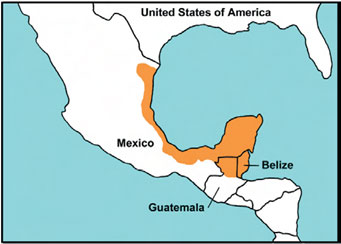 Crocodylus moreletii occurs on the Atlantic regions of Central America (Mexico, Belize, Guatemala). It rarely exceeds 3 m in length, and typically inhabits freshwater lagoons, streams and swamps, and sometimes rivers. In the dry season individuals sometimes burrow into mud banks, to wait for the wet season.
Crocodylus moreletii occurs on the Atlantic regions of Central America (Mexico, Belize, Guatemala). It rarely exceeds 3 m in length, and typically inhabits freshwater lagoons, streams and swamps, and sometimes rivers. In the dry season individuals sometimes burrow into mud banks, to wait for the wet season.
Females lay their eggs (20-45) in a mound nest, usually a few metres from water, although some 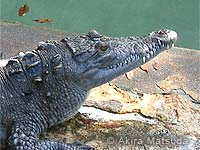 nests are constructed on floating rafts of vegetation. In Mexico nesting occurs in April-June. Hatchlings are about 17 cm long when they hatch, and are guarded by the female for a time.
nests are constructed on floating rafts of vegetation. In Mexico nesting occurs in April-June. Hatchlings are about 17 cm long when they hatch, and are guarded by the female for a time.
The belly skin of C. moreletii lacks osteoderms, thus it has been intensively hunted for its skin. Habitat modification is also a threat, particularly when it allows hunters access to crocodile refuges.
Mugger Crocodile (Crocodylus palustris)
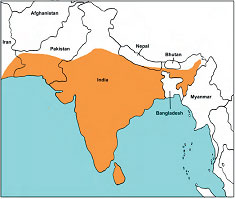 The Mugger is perhaps the most "broad-snouted" of the "true" crocodiles. The name mugger derives from the Indian ‘Magar-Machh’ what can also mean Swamp crocodile. The species is found in India, Pakistan and Iran, and is quite abundant in Sri Lanka where they occur in the numerous man-made lakes there. Although some individuals may reach 5 m in length, they do not generally exceed 3-4 m. They prefer fresh, still waters, with depths between 3 and 5 m, but are sometimes found in brackish water. In the summer and winter months they burrow into pond and riverbanks to escape hot and cold conditions respectively. In some cases these burrows may be up to 10 m long. The diet consists of a variety of invertebrates, fish and birds.
The Mugger is perhaps the most "broad-snouted" of the "true" crocodiles. The name mugger derives from the Indian ‘Magar-Machh’ what can also mean Swamp crocodile. The species is found in India, Pakistan and Iran, and is quite abundant in Sri Lanka where they occur in the numerous man-made lakes there. Although some individuals may reach 5 m in length, they do not generally exceed 3-4 m. They prefer fresh, still waters, with depths between 3 and 5 m, but are sometimes found in brackish water. In the summer and winter months they burrow into pond and riverbanks to escape hot and cold conditions respectively. In some cases these burrows may be up to 10 m long. The diet consists of a variety of invertebrates, fish and birds.
In captivity, female C. palustris start laying eggs when they are 1.7-2.0 m long, and 6 years of age. Males are sexually mature at 2.6 m and 10 years of age. In the wild, individuals do not grow as fast as those in captivity, and so they are probably older when they reach sexual maturity. Females lay their eggs in sandbanks, between February and April, and hatching occurs between April and June. One of the unique features of Muggers is that they appear to be the only species of living crocodilian that regularly breeds twice in any one year, with different clutches being laid between 30 and 57 days apart. This may be related to the two monsoonal influences that occur in Sri Lanka and southern India each year.
Mongoose, jackals and monitor lizards are predators on the eggs, and herons and storks eat hatchlings. Further egg mortality may be caused by flooding and desiccation. As with the other species of crocodilian in India, the pressures of a large human population, and hunting in the past, reduced the numbers of C. palustris. In India, wild mugger populations have been boosted by a conservation program involving the restocking of depleted rivers with juveniles raised in captivity.
New Guinea Freshwater Crocodile (Crocodylus novaeguineae*)
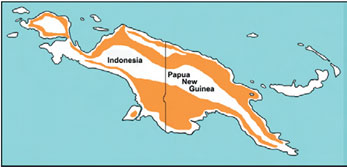 Crocodylus novaeguineae is widely distributed in vast areas of heavily vegetated freshwater swamp in Papua New Guinea and Papua Province (Indonesia). There are two disjunct populations: One along the north shores and the other part occupies the Central and Southern parts of the large island. Despite continual hunting for decades, there is currently no larger concern for extinction of this species. Both countries, Papua New Guinea and Indonesia, imposed a law limiting the maximum belly skin size (51 cm in width) for export, in order to protect wild adult individuals from hunting.
Crocodylus novaeguineae is widely distributed in vast areas of heavily vegetated freshwater swamp in Papua New Guinea and Papua Province (Indonesia). There are two disjunct populations: One along the north shores and the other part occupies the Central and Southern parts of the large island. Despite continual hunting for decades, there is currently no larger concern for extinction of this species. Both countries, Papua New Guinea and Indonesia, imposed a law limiting the maximum belly skin size (51 cm in width) for export, in order to protect wild adult individuals from hunting.
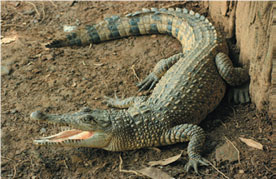 In some areas landowners regularly collect juveniles and sell them to traders who pass them on to crocodile farms. Selling a few crocodiles may provide the entire cash income for people in remote rural areas. An egg harvest program was initiated in the Sepik River area of Papua New Guinea, with income also being generated from the sale of these eggs. The benefits of selling the eggs to a crocodile farm are much higher than raiding the nests (for food) and killing the breeding female. In order to compensate the people for the loss of animal protein from eating the eggs, landowners are given chicken eggs along with a cash payment.
In some areas landowners regularly collect juveniles and sell them to traders who pass them on to crocodile farms. Selling a few crocodiles may provide the entire cash income for people in remote rural areas. An egg harvest program was initiated in the Sepik River area of Papua New Guinea, with income also being generated from the sale of these eggs. The benefits of selling the eggs to a crocodile farm are much higher than raiding the nests (for food) and killing the breeding female. In order to compensate the people for the loss of animal protein from eating the eggs, landowners are given chicken eggs along with a cash payment.
The New Guinea Freshwater crocodile is a mound-nesting species. Maturity is reached between 8 and 12 years, with females having a size of about 1.8-2.0 m, and males of 2.0-2.5 m. Maximum size is 3 m for females and 3.5 m for males. Generally, females do not protect their nests, and will retreat quickly when approached – a behaviour that may not be natural but having developed due to the regular visits by landowners to collect eggs. Beside human predation, eggs are lost to flooding. The northern population of C. novaeguineae, nests in the dry season and has an average clutch size of 35 eggs. The southern population nests mainly in the wet season, with an average clutch size of 22 eggs. This suggests that there may be two distinct "types" of C. novaeguineae in Papua New Guinea. However, morphological and genetic studies could not reveal any significant difference between the populations.
Nile Crocodile (Crocodylus niloticus*)
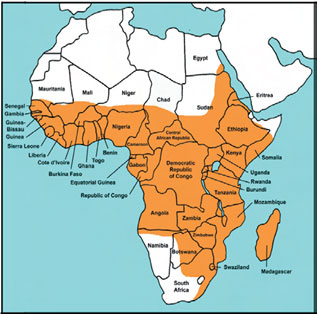 The Nile crocodile is a large crocodile, with adult males commonly exceeding 4 m in length. It is a gregarious species, and so it is not uncommon to see large numbers lying side by side on riverbanks. The species is widely distributed in Africa (Angola, Benin, Botswana, Burkina Faso, Burundi, Cameroon, Central African Republic, Chad, Congo, Cote d’Ivoire, Democratic Republic of Congo, Egypt, Eritrea, Ethiopia, Equatorial Guinea, Gabon, Gambia, Ghana, Guinea, Guinea Bissau, Kenya, Liberia, Madagascar, Malawi, Mali, Mozambique, Mauritania, Namibia, Niger, Nigeria, Rwanda, Senegal, Sierra Leone, Somalia, South Africa, Sudan, Swaziland, Tanzania, Togo, Uganda, Zambia, Zimbabwe) and is a species upon which a considerable research effort has been expended. In historical times the crocodiles were deificated by the Egyptians as god ‘Sobek’(greek: Suchos). During the 20th Century it shaped the general public image of crocodiles by appearing throughout numerous Tarzan movies. Today, its skin is highly prized for fashion leather.
The Nile crocodile is a large crocodile, with adult males commonly exceeding 4 m in length. It is a gregarious species, and so it is not uncommon to see large numbers lying side by side on riverbanks. The species is widely distributed in Africa (Angola, Benin, Botswana, Burkina Faso, Burundi, Cameroon, Central African Republic, Chad, Congo, Cote d’Ivoire, Democratic Republic of Congo, Egypt, Eritrea, Ethiopia, Equatorial Guinea, Gabon, Gambia, Ghana, Guinea, Guinea Bissau, Kenya, Liberia, Madagascar, Malawi, Mali, Mozambique, Mauritania, Namibia, Niger, Nigeria, Rwanda, Senegal, Sierra Leone, Somalia, South Africa, Sudan, Swaziland, Tanzania, Togo, Uganda, Zambia, Zimbabwe) and is a species upon which a considerable research effort has been expended. In historical times the crocodiles were deificated by the Egyptians as god ‘Sobek’(greek: Suchos). During the 20th Century it shaped the general public image of crocodiles by appearing throughout numerous Tarzan movies. Today, its skin is highly prized for fashion leather.
Nesting of C. niloticus takes place in the dry season (September), with females digging a hole-type nest next to permanent water, and laying an average of 60 eggs. The female attends the nest, and may defend it against predators. Even so, there is still high egg mortality due to predators, mainly varanid lizards and mammals. Hatchlings also experience a high mortality. Because of these losses, eggs are collected and incubated by crocodile farmers each year, to provide stock for their farms. These ranching programs appear to have had little impact on the size of the wild populations, and provide economic incentives for the long-term conservation of crocodiles.
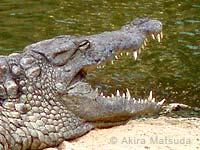 Like other crocodilians, the Nile crocodile is an opportunistic feeder. Insects are the main food of young crocodiles, but as they increase in size, so does the prey on which they feed. Nile crocodiles are responsible for more human deaths than any other crocodilian. For example, in Zimbabwe crocodiles are responsible for more human fatalities than all the other wild animals combined, and many more deaths occur in other African countries (eg Tanzania) where the limited water available in the dry season must suffice for both people and crocodiles.
Like other crocodilians, the Nile crocodile is an opportunistic feeder. Insects are the main food of young crocodiles, but as they increase in size, so does the prey on which they feed. Nile crocodiles are responsible for more human deaths than any other crocodilian. For example, in Zimbabwe crocodiles are responsible for more human fatalities than all the other wild animals combined, and many more deaths occur in other African countries (eg Tanzania) where the limited water available in the dry season must suffice for both people and crocodiles.
Orinoco Crocodile (Crocodylus intermedius)
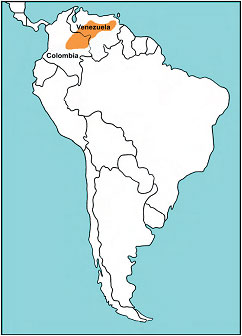
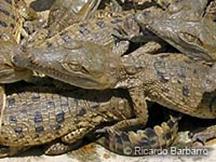 The Orinoco Crocodile is restricted to the Orinoco River drainage in Venezuela and Colombia. Historically distributed in a variety of habitats, it reached its greatest numbers in rivers of the Llanos region of Venezuela. As a result of uncontrolled hunting for skins (1920s-1940s), numbers of Crocodylus intermedius were greatly reduced. However, a determined conservation effort in Venezuela, based on ranching of eggs and subsequent release of juveniles back into the wild, has seen the wild population increase significantly from low levels 30 years ago.
The Orinoco Crocodile is restricted to the Orinoco River drainage in Venezuela and Colombia. Historically distributed in a variety of habitats, it reached its greatest numbers in rivers of the Llanos region of Venezuela. As a result of uncontrolled hunting for skins (1920s-1940s), numbers of Crocodylus intermedius were greatly reduced. However, a determined conservation effort in Venezuela, based on ranching of eggs and subsequent release of juveniles back into the wild, has seen the wild population increase significantly from low levels 30 years ago.
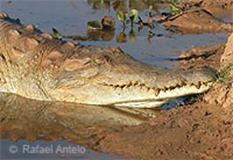 In January-February, the end of the dry season, females lay 15-70 eggs in a hole-nest in sandbars and riverbanks. Hatchlings emerge around May, just before the wet season. The main diet of young individuals is insects, crabs, snails and other invertebrates. Adults feed mainly on fish, mammals and birds.
In January-February, the end of the dry season, females lay 15-70 eggs in a hole-nest in sandbars and riverbanks. Hatchlings emerge around May, just before the wet season. The main diet of young individuals is insects, crabs, snails and other invertebrates. Adults feed mainly on fish, mammals and birds.
Large male C. intermedius may exceed 4-5 m in length and one specimen was reputed to have reached nearly 7 m. As a large crocodilian the Orinoco Crocodile is often viewed as a threat to people and livestock. However, attacks on people have rarely, if ever, been reported.
Philippine Crocodile (Crocodylus mindorensis*)
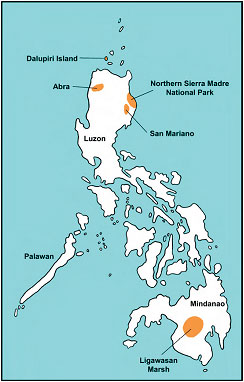 Previously widely distributed throughout the Philippines, Crocodylus mindorensis now occurs on the islands of Mindanao, Mindoro, Negros and Luzon. Initial decline in numbers was due to hunting, but now habitat modification (rivers, lakes and swamps) is the major threat to existing populations. Although no definitive population estimates are available, the total wild population is believed to be small (perhaps <100 non-hatchlings). Some captive breeding is being carried out, and a program is now in place to establish protected areas where C. mindorensis can be released back into the wild.
Previously widely distributed throughout the Philippines, Crocodylus mindorensis now occurs on the islands of Mindanao, Mindoro, Negros and Luzon. Initial decline in numbers was due to hunting, but now habitat modification (rivers, lakes and swamps) is the major threat to existing populations. Although no definitive population estimates are available, the total wild population is believed to be small (perhaps <100 non-hatchlings). Some captive breeding is being carried out, and a program is now in place to establish protected areas where C. mindorensis can be released back into the wild.
Adults rarely exceed 2-3 m, and only the largest males sometimes reach 4 m in length. If at all there are only few data available on the species’ reproductive behaviour and hatchling care. Eggs are laid in a mound nest at the end of the dry season (June-July). Clutch sizes are small (7-20 eggs). The female will guard the nest during the incubation period, which is usually 3 months long.
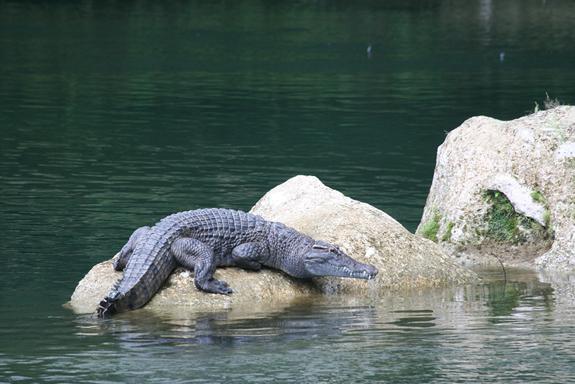
Saltwater Crocodile (Crocodylus porosus)
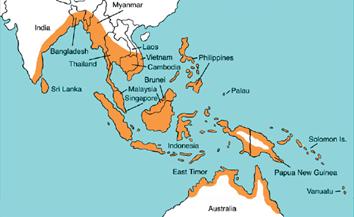 The Saltwater or Estuarine Crocodile is the largest of all crocodilians, which makes it a good contender for the largest living reptile on earth. The normal maximum size of adult males is 5 to 6 m, with some individuals even reaching 7 m. There are reports of three specimens reaching 8-10 m, but there are no "parts" of the animals in existence with which to substantiate the claims.
The Saltwater or Estuarine Crocodile is the largest of all crocodilians, which makes it a good contender for the largest living reptile on earth. The normal maximum size of adult males is 5 to 6 m, with some individuals even reaching 7 m. There are reports of three specimens reaching 8-10 m, but there are no "parts" of the animals in existence with which to substantiate the claims.
Saltwater Crocodiles are distributed from Sri Lanka and the east coast of India in the west, to the Caroline Islands in the east, from Myanmar and Southeast Asia in the north, to Australia in the south. They live in tidal and freshwater rivers and swamps, and often travel around the coastline.
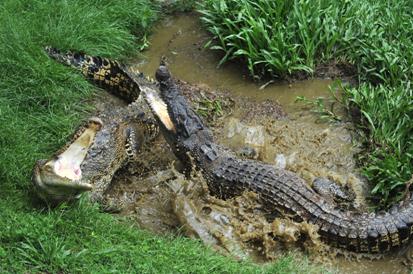 In the wild, males mature at around 3.1 m (17 years), and females at around 2.1 m (12 years). Females nest in the wet season (October-May in northern Australia), laying an average of 50 eggs in a mound nest. Interestingly, in Papua New Guinea mean clutch size is higher than in Australia, but the eggs are smaller - total clutch mass is similar in both areas. Females actively guard their nests, and non-human predation on eggs is negligible. However, mortality due to flooding and overheating is high (mean= <80%), and in some areas 100% of eggs may be lost to environmental factors.
In the wild, males mature at around 3.1 m (17 years), and females at around 2.1 m (12 years). Females nest in the wet season (October-May in northern Australia), laying an average of 50 eggs in a mound nest. Interestingly, in Papua New Guinea mean clutch size is higher than in Australia, but the eggs are smaller - total clutch mass is similar in both areas. Females actively guard their nests, and non-human predation on eggs is negligible. However, mortality due to flooding and overheating is high (mean= <80%), and in some areas 100% of eggs may be lost to environmental factors.
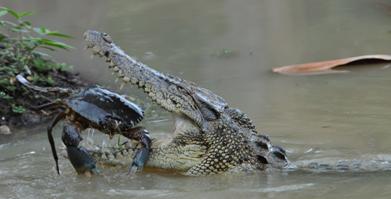 Saltwater crocodiles tend to eat even in the cooler times of the year, and anything that can be overpowered may be taken, including livestock (horses, cattle, buffalo, pigs) and even humans. In the Northern Territory, a “problem crocodile” program results in around 240 Saltwater Crocodiles being removed annually from Darwin Harbour, to improve public safety. The size structure of the population in the Northern Territory is skewed towards a higher proportion of larger individuals, and research indicates that numbers of small crocodiles are dependent on the numbers of large crocodiles.
Saltwater crocodiles tend to eat even in the cooler times of the year, and anything that can be overpowered may be taken, including livestock (horses, cattle, buffalo, pigs) and even humans. In the Northern Territory, a “problem crocodile” program results in around 240 Saltwater Crocodiles being removed annually from Darwin Harbour, to improve public safety. The size structure of the population in the Northern Territory is skewed towards a higher proportion of larger individuals, and research indicates that numbers of small crocodiles are dependent on the numbers of large crocodiles.
The skin of Saltwater Crocodiles is the most prized of all crocodilian skins for fashion leather. In Australia sustainable use programs operate in the Northern Territory and Western Australia, based largely on harvesting of eggs and subsequent rearing of hatchlings on farms. In Papua New Guinea an egg and juvenile ranching program also exists, and there is a harvest of wild animals. In Papua Province (Indonesia) ranching of hatchlings and juveniles occurs, as well as a wild harvest. In other parts of the species’ range, wild populations are depleted, and trade relies on closed cycle captive breeding (eg Malaysia, Singapore, Thailand, and Vietnam).
Siamese Crocodile (Crocodylus siamensis)
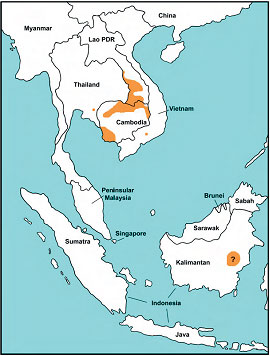 The Siamese Crocodile was once reasonably abundant in the freshwater swamps and slow moving rivers of Thailand, as well as parts of Vietnam, Cambodia, Lao PDR and parts of the Malayan Peninsula and Indonesia. During the middle and end of the 20th Century wild populations have been suffering great losses, mainly due to hunting and harvesting. Today, the only wild populations are known from Cambodia and Indonesia (Kalimantan). Small and scattered population remnants persist in parts of Lao PDR. In Vietnam and Thailand C. siamensis is considered to be extinct in the wild. Thus, C. siamensis is one of six critically endangered crocodilian species on the IUCN Red List.
The Siamese Crocodile was once reasonably abundant in the freshwater swamps and slow moving rivers of Thailand, as well as parts of Vietnam, Cambodia, Lao PDR and parts of the Malayan Peninsula and Indonesia. During the middle and end of the 20th Century wild populations have been suffering great losses, mainly due to hunting and harvesting. Today, the only wild populations are known from Cambodia and Indonesia (Kalimantan). Small and scattered population remnants persist in parts of Lao PDR. In Vietnam and Thailand C. siamensis is considered to be extinct in the wild. Thus, C. siamensis is one of six critically endangered crocodilian species on the IUCN Red List.
Re-introduction efforts were undertaken in Pang Sida National Park (eastern Thailand) and Cat Tien National Park (southern Vietnam). The Cat Tien program succeeded in establishing a viable population in the Bau Sau wetlands. Here, breeding of several nests occurs constantly since 2005.
 Quite recently, a persisting wild population was detected in the Mesangat swamps adjacent to Mahakam River in Eastern Borneo. Being bought by an English palm oil company the area was provided for conservation and status assessments are currently on their way.
Quite recently, a persisting wild population was detected in the Mesangat swamps adjacent to Mahakam River in Eastern Borneo. Being bought by an English palm oil company the area was provided for conservation and status assessments are currently on their way.
Male (up) and Female (below) Siamese Crocodiles in the Swamps of Southern Viet Nam

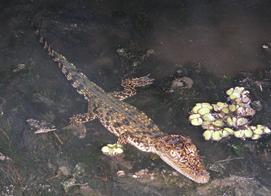 C. siamensis is a medium sized species with males reaching lengths of 3-4 m, while females usually not exceed 2.5 m. In captivity, sexual maturity is reached after 10-12 years. Eggs are laid in a mound nest in April-May and hatching occurs between June and August. In contrast to almost all other crocodilian species the typical post-hatching parental care is implemented by both, male and female. Due to its shy nature and the severe population depletion in the past, ecological data are scarce and further research efforts are necessary to provide a basis for the survival of the species.
C. siamensis is a medium sized species with males reaching lengths of 3-4 m, while females usually not exceed 2.5 m. In captivity, sexual maturity is reached after 10-12 years. Eggs are laid in a mound nest in April-May and hatching occurs between June and August. In contrast to almost all other crocodilian species the typical post-hatching parental care is implemented by both, male and female. Due to its shy nature and the severe population depletion in the past, ecological data are scarce and further research efforts are necessary to provide a basis for the survival of the species.
However, unlike in the wild, there are large stocks of C. siamensis in captivity in Cambodia, Thailand and Vietnam. Several 100,000s of animals are held and bred for leather and meat production. On the farms, hybridisation is induced between C. siamensis and C. porosus and C. rhombifer. Although unnatural hybridisation is a delicate topic, it is further encouraged by the result of fast growing but calm animals, with large clutches and superior skins.
Tomistoma (Tomistoma schlegelii*)
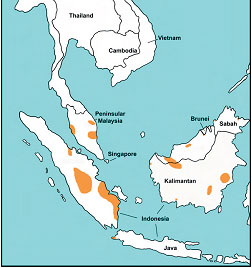
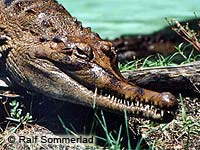 Like the Gharial, the most obvious character of Tomistoma (formerly also known as False Gharial) is its long, slender snout. The species is found in the Malaysian-Indonesian region. Main strongholds are the State sof Sabah, Sarawak and Kalimantan on Borneo. Fragmented remnant populations can be found throughout Sumatra and recently, the species was rediscovered on Java. Occurrences on Sulawesi and Vietnam still need confirmation. It is extirpated in southern Thailand and the Malayan Peninsula. Although surveys are difficult the Tomistoma population in the wild is estimated to consist of less than 2500 individuals. Thus, Tomistoma schlegelii is listed as endangered (EN) on the IUCN Red List. Within the CSG, a specific working group, the Tomistoma Task Force [interlink with major conservation initiatives], was established.
Like the Gharial, the most obvious character of Tomistoma (formerly also known as False Gharial) is its long, slender snout. The species is found in the Malaysian-Indonesian region. Main strongholds are the State sof Sabah, Sarawak and Kalimantan on Borneo. Fragmented remnant populations can be found throughout Sumatra and recently, the species was rediscovered on Java. Occurrences on Sulawesi and Vietnam still need confirmation. It is extirpated in southern Thailand and the Malayan Peninsula. Although surveys are difficult the Tomistoma population in the wild is estimated to consist of less than 2500 individuals. Thus, Tomistoma schlegelii is listed as endangered (EN) on the IUCN Red List. Within the CSG, a specific working group, the Tomistoma Task Force [interlink with major conservation initiatives], was established.
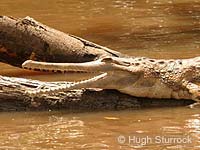 Until recently, little was known of the biology and ecology of Tomistoma. This was mainly due to its shy and seclusive nature. Animals are reported to reach sizes of maximum 7 m, with most animals ranging between 3 and 5 m. In the wild, Tomistoma were observed digging holes or using existing cavities where they may spend drier parts of the year. Adult individuals are predominantly fish-eaters, although other larger prey (mammals, birds) may also be taken.
Until recently, little was known of the biology and ecology of Tomistoma. This was mainly due to its shy and seclusive nature. Animals are reported to reach sizes of maximum 7 m, with most animals ranging between 3 and 5 m. In the wild, Tomistoma were observed digging holes or using existing cavities where they may spend drier parts of the year. Adult individuals are predominantly fish-eaters, although other larger prey (mammals, birds) may also be taken.
Females mature at around 2.5-3.0 m in length (20 years of age), and are mound-nesters. Between 20 and 60 eggs are laid in the dry season, and hatchlings appear after 72-90 days, at the beginning of the wet season. Lizards and wild pigs are main predators on the eggs, which are the largest among all the crocodilian species.
There are large numbers of Tomistoma in captivity, but they have rarely bred in captivity, which is unusual - most crocodilians breed well once they settle into captive situations. One farm in Thailand is consistently producing hatchlings and one farm in Sarawak has produced some hatchlings, but overall there are still many individuals that simply do not breed.

 Email CSG
Email CSG
 The American Crocodile is another widely distributed species. It extends from a relict population in Florid (USA), through the Caribbean Islands and along the coast of Central America to the northern coast of South America. Throughout much of this range numbers have been greatly reduced, although significant populations still occur in Haiti, the Dominican Republic and Cuba. It occupies coastal habitats such as mangrove swamps and brackish bays, large lakes, and may extend well upstream in coastal rivers. American crocodiles are capable of moving considerable distances, and some individuals that have strayed out of their normal range have been found in the Cayman Islands and Trinidad.
The American Crocodile is another widely distributed species. It extends from a relict population in Florid (USA), through the Caribbean Islands and along the coast of Central America to the northern coast of South America. Throughout much of this range numbers have been greatly reduced, although significant populations still occur in Haiti, the Dominican Republic and Cuba. It occupies coastal habitats such as mangrove swamps and brackish bays, large lakes, and may extend well upstream in coastal rivers. American crocodiles are capable of moving considerable distances, and some individuals that have strayed out of their normal range have been found in the Cayman Islands and Trinidad. The species is a moderately sized crocodilian that can at times exceed 4 m in length. Females appear to be primarily hole-nesters, although in Florida both hole and mound nests may be used. Females supposedly return to the same nesting site each year, and are thought to reach sexual maturity at about 2.5 m in length.
The species is a moderately sized crocodilian that can at times exceed 4 m in length. Females appear to be primarily hole-nesters, although in Florida both hole and mound nests may be used. Females supposedly return to the same nesting site each year, and are thought to reach sexual maturity at about 2.5 m in length.
 The Australian Freshwater Crocodile or Johnston's River crocodile is endemic to mainland Australia. It is a small species, seldom exceeding 3 m, with a narrow snout resembling that of Tomistoma. The species was hunted for its skin up to the early 1970s, but has now largely recovered from the effects of past hunting. The full impact of introduced cane toads (Bufo marinus) on wild C. johnstoni populations is not known, but adult and juvenile mortalities (as high as 77%) have been reported in areas once the toads arrive. The species is known to be more susceptible to cane toad toxin than the Saltwater Crocodile (C. porosus).
The Australian Freshwater Crocodile or Johnston's River crocodile is endemic to mainland Australia. It is a small species, seldom exceeding 3 m, with a narrow snout resembling that of Tomistoma. The species was hunted for its skin up to the early 1970s, but has now largely recovered from the effects of past hunting. The full impact of introduced cane toads (Bufo marinus) on wild C. johnstoni populations is not known, but adult and juvenile mortalities (as high as 77%) have been reported in areas once the toads arrive. The species is known to be more susceptible to cane toad toxin than the Saltwater Crocodile (C. porosus). Nesting occurs during the dry season (August-September), with clutch sizes averaging 13 eggs. Eggs are laid in a hole nest dug in friable substrates, and females do not guard their nests/eggs. Hatching occurs in November-December, before wet season rains begin. Prior to colonisation by cane toads, egg mortality was high (<90-95%), mainly the result of predation by goannas (monitor lizards). In one area where data are available, egg mortality has now decreased to <50%, and hatchling recruitment has increased by 400% or more, as goanna numbers were greatly reduced by the arrival of toads.
Nesting occurs during the dry season (August-September), with clutch sizes averaging 13 eggs. Eggs are laid in a hole nest dug in friable substrates, and females do not guard their nests/eggs. Hatching occurs in November-December, before wet season rains begin. Prior to colonisation by cane toads, egg mortality was high (<90-95%), mainly the result of predation by goannas (monitor lizards). In one area where data are available, egg mortality has now decreased to <50%, and hatchling recruitment has increased by 400% or more, as goanna numbers were greatly reduced by the arrival of toads. The swamp dwelling Cuban Crocodiles are medium sized, hole nesting animals, which mainly feed on fish, turtles and small mammals. Apart from that only few ecological data are available. The crocodiles are endemic to Cuba, where they are restricted to Zapata Swamp on the mainland, and Lanier Swamp on the Isle of Youth (previously named Isle of Pines). In 1959-60 several hundred adult C. rhombifer were translocated to enclosures within Zapata Swamp, when they were under threat from agricultural development. The development did not go ahead, but the crocodiles remained within the enclosures, where they mixed with Crocodylus acutus. The two species interbreed, and pure-bred C. rhombifer are now outnumbered by hybrids.
The swamp dwelling Cuban Crocodiles are medium sized, hole nesting animals, which mainly feed on fish, turtles and small mammals. Apart from that only few ecological data are available. The crocodiles are endemic to Cuba, where they are restricted to Zapata Swamp on the mainland, and Lanier Swamp on the Isle of Youth (previously named Isle of Pines). In 1959-60 several hundred adult C. rhombifer were translocated to enclosures within Zapata Swamp, when they were under threat from agricultural development. The development did not go ahead, but the crocodiles remained within the enclosures, where they mixed with Crocodylus acutus. The two species interbreed, and pure-bred C. rhombifer are now outnumbered by hybrids. Hybridisation also occurs naturally in the wild population. Some Cuban Crocodiles were transported to Vietnam and later to Cambodia, and hybridisation has occurred with the Siamese crocodile (C. siamensis) in both countries.
Hybridisation also occurs naturally in the wild population. Some Cuban Crocodiles were transported to Vietnam and later to Cambodia, and hybridisation has occurred with the Siamese crocodile (C. siamensis) in both countries. The Dwarf Crocodile is restricted to Central and West Africa (Angola, Benin, Burkina Faso, Cameroon, Central African Republic, Congo, Cote d’Ivoire, Dem. Rep. Congo, Equatorial Guinea, Gabon, Gambia, Ghana, Guinea, Guinea-Bissau, Liberia, Mali, Nigeria, Senegal, Sierra Leone, Togo), and its biology and ecology are very poorly known. It rarely exceeds 2 m in length - average adult size is 1.0-1.5 m. In appearance, it resembles the dwarf caimans of South America, but it is of course in a totally different subfamily.
The Dwarf Crocodile is restricted to Central and West Africa (Angola, Benin, Burkina Faso, Cameroon, Central African Republic, Congo, Cote d’Ivoire, Dem. Rep. Congo, Equatorial Guinea, Gabon, Gambia, Ghana, Guinea, Guinea-Bissau, Liberia, Mali, Nigeria, Senegal, Sierra Leone, Togo), and its biology and ecology are very poorly known. It rarely exceeds 2 m in length - average adult size is 1.0-1.5 m. In appearance, it resembles the dwarf caimans of South America, but it is of course in a totally different subfamily.
 It is a nocturnal species, and is rarely seen during the day. Generally docile and timid in nature, Dwarf Crocodiles do not congregate in large numbers, and are usually solitary. They are associated with tropical rainforests, and tend to avoid large watercourses. Frogs, fish and crabs are the major prey items. In captivity, females lay 11-17 eggs in a mound nest around June-July. Large osteoderms in the skin, nocturnal habits and small size have saved the species from the intense exploitation that Crocodylus niloticus has suffered, though some hunting still occurs, mainly for meat.
It is a nocturnal species, and is rarely seen during the day. Generally docile and timid in nature, Dwarf Crocodiles do not congregate in large numbers, and are usually solitary. They are associated with tropical rainforests, and tend to avoid large watercourses. Frogs, fish and crabs are the major prey items. In captivity, females lay 11-17 eggs in a mound nest around June-July. Large osteoderms in the skin, nocturnal habits and small size have saved the species from the intense exploitation that Crocodylus niloticus has suffered, though some hunting still occurs, mainly for meat. Crocodylus moreletii occurs on the Atlantic regions of Central America (Mexico, Belize, Guatemala). It rarely exceeds 3 m in length, and typically inhabits freshwater lagoons, streams and swamps, and sometimes rivers. In the dry season individuals sometimes burrow into mud banks, to wait for the wet season.
Crocodylus moreletii occurs on the Atlantic regions of Central America (Mexico, Belize, Guatemala). It rarely exceeds 3 m in length, and typically inhabits freshwater lagoons, streams and swamps, and sometimes rivers. In the dry season individuals sometimes burrow into mud banks, to wait for the wet season.  nests are constructed on floating rafts of vegetation. In Mexico nesting occurs in April-June. Hatchlings are about 17 cm long when they hatch, and are guarded by the female for a time.
nests are constructed on floating rafts of vegetation. In Mexico nesting occurs in April-June. Hatchlings are about 17 cm long when they hatch, and are guarded by the female for a time. The Mugger is perhaps the most "broad-snouted" of the "true" crocodiles. The name mugger derives from the Indian ‘Magar-Machh’ what can also mean Swamp crocodile. The species is found in India, Pakistan and Iran, and is quite abundant in Sri Lanka where they occur in the numerous man-made lakes there. Although some individuals may reach 5 m in length, they do not generally exceed 3-4 m. They prefer fresh, still waters, with depths between 3 and 5 m, but are sometimes found in brackish water. In the summer and winter months they burrow into pond and riverbanks to escape hot and cold conditions respectively. In some cases these burrows may be up to 10 m long. The diet consists of a variety of invertebrates, fish and birds.
The Mugger is perhaps the most "broad-snouted" of the "true" crocodiles. The name mugger derives from the Indian ‘Magar-Machh’ what can also mean Swamp crocodile. The species is found in India, Pakistan and Iran, and is quite abundant in Sri Lanka where they occur in the numerous man-made lakes there. Although some individuals may reach 5 m in length, they do not generally exceed 3-4 m. They prefer fresh, still waters, with depths between 3 and 5 m, but are sometimes found in brackish water. In the summer and winter months they burrow into pond and riverbanks to escape hot and cold conditions respectively. In some cases these burrows may be up to 10 m long. The diet consists of a variety of invertebrates, fish and birds.  Crocodylus novaeguineae is widely distributed in vast areas of heavily vegetated freshwater swamp in Papua New Guinea and Papua Province (Indonesia). There are two disjunct populations: One along the north shores and the other part occupies the Central and Southern parts of the large island. Despite continual hunting for decades, there is currently no larger concern for extinction of this species. Both countries, Papua New Guinea and Indonesia, imposed a law limiting the maximum belly skin size (51 cm in width) for export, in order to protect wild adult individuals from hunting.
Crocodylus novaeguineae is widely distributed in vast areas of heavily vegetated freshwater swamp in Papua New Guinea and Papua Province (Indonesia). There are two disjunct populations: One along the north shores and the other part occupies the Central and Southern parts of the large island. Despite continual hunting for decades, there is currently no larger concern for extinction of this species. Both countries, Papua New Guinea and Indonesia, imposed a law limiting the maximum belly skin size (51 cm in width) for export, in order to protect wild adult individuals from hunting. In some areas landowners regularly collect juveniles and sell them to traders who pass them on to crocodile farms. Selling a few crocodiles may provide the entire cash income for people in remote rural areas. An egg harvest program was initiated in the Sepik River area of Papua New Guinea, with income also being generated from the sale of these eggs. The benefits of selling the eggs to a crocodile farm are much higher than raiding the nests (for food) and killing the breeding female. In order to compensate the people for the loss of animal protein from eating the eggs, landowners are given chicken eggs along with a cash payment.
In some areas landowners regularly collect juveniles and sell them to traders who pass them on to crocodile farms. Selling a few crocodiles may provide the entire cash income for people in remote rural areas. An egg harvest program was initiated in the Sepik River area of Papua New Guinea, with income also being generated from the sale of these eggs. The benefits of selling the eggs to a crocodile farm are much higher than raiding the nests (for food) and killing the breeding female. In order to compensate the people for the loss of animal protein from eating the eggs, landowners are given chicken eggs along with a cash payment.  The Nile crocodile is a large crocodile, with adult males commonly exceeding 4 m in length. It is a gregarious species, and so it is not uncommon to see large numbers lying side by side on riverbanks. The species is widely distributed in Africa (Angola, Benin, Botswana, Burkina Faso, Burundi, Cameroon, Central African Republic, Chad, Congo, Cote d’Ivoire, Democratic Republic of Congo, Egypt, Eritrea, Ethiopia, Equatorial Guinea, Gabon, Gambia, Ghana, Guinea, Guinea Bissau, Kenya, Liberia, Madagascar, Malawi, Mali, Mozambique, Mauritania, Namibia, Niger, Nigeria, Rwanda, Senegal, Sierra Leone, Somalia, South Africa, Sudan, Swaziland, Tanzania, Togo, Uganda, Zambia, Zimbabwe) and is a species upon which a considerable research effort has been expended. In historical times the crocodiles were deificated by the Egyptians as god ‘Sobek’(greek: Suchos). During the 20th Century it shaped the general public image of crocodiles by appearing throughout numerous Tarzan movies. Today, its skin is highly prized for fashion leather.
The Nile crocodile is a large crocodile, with adult males commonly exceeding 4 m in length. It is a gregarious species, and so it is not uncommon to see large numbers lying side by side on riverbanks. The species is widely distributed in Africa (Angola, Benin, Botswana, Burkina Faso, Burundi, Cameroon, Central African Republic, Chad, Congo, Cote d’Ivoire, Democratic Republic of Congo, Egypt, Eritrea, Ethiopia, Equatorial Guinea, Gabon, Gambia, Ghana, Guinea, Guinea Bissau, Kenya, Liberia, Madagascar, Malawi, Mali, Mozambique, Mauritania, Namibia, Niger, Nigeria, Rwanda, Senegal, Sierra Leone, Somalia, South Africa, Sudan, Swaziland, Tanzania, Togo, Uganda, Zambia, Zimbabwe) and is a species upon which a considerable research effort has been expended. In historical times the crocodiles were deificated by the Egyptians as god ‘Sobek’(greek: Suchos). During the 20th Century it shaped the general public image of crocodiles by appearing throughout numerous Tarzan movies. Today, its skin is highly prized for fashion leather.  Like other crocodilians, the Nile crocodile is an opportunistic feeder. Insects are the main food of young crocodiles, but as they increase in size, so does the prey on which they feed. Nile crocodiles are responsible for more human deaths than any other crocodilian. For example, in Zimbabwe crocodiles are responsible for more human fatalities than all the other wild animals combined, and many more deaths occur in other African countries (eg Tanzania) where the limited water available in the dry season must suffice for both people and crocodiles.
Like other crocodilians, the Nile crocodile is an opportunistic feeder. Insects are the main food of young crocodiles, but as they increase in size, so does the prey on which they feed. Nile crocodiles are responsible for more human deaths than any other crocodilian. For example, in Zimbabwe crocodiles are responsible for more human fatalities than all the other wild animals combined, and many more deaths occur in other African countries (eg Tanzania) where the limited water available in the dry season must suffice for both people and crocodiles.
 The Orinoco Crocodile is restricted to the Orinoco River drainage in Venezuela and Colombia. Historically distributed in a variety of habitats, it reached its greatest numbers in rivers of the Llanos region of Venezuela. As a result of uncontrolled hunting for skins (1920s-1940s), numbers of Crocodylus intermedius were greatly reduced. However, a determined conservation effort in Venezuela, based on ranching of eggs and subsequent release of juveniles back into the wild, has seen the wild population increase significantly from low levels 30 years ago.
The Orinoco Crocodile is restricted to the Orinoco River drainage in Venezuela and Colombia. Historically distributed in a variety of habitats, it reached its greatest numbers in rivers of the Llanos region of Venezuela. As a result of uncontrolled hunting for skins (1920s-1940s), numbers of Crocodylus intermedius were greatly reduced. However, a determined conservation effort in Venezuela, based on ranching of eggs and subsequent release of juveniles back into the wild, has seen the wild population increase significantly from low levels 30 years ago. In January-February, the end of the dry season, females lay 15-70 eggs in a hole-nest in sandbars and riverbanks. Hatchlings emerge around May, just before the wet season. The main diet of young individuals is insects, crabs, snails and other invertebrates. Adults feed mainly on fish, mammals and birds.
In January-February, the end of the dry season, females lay 15-70 eggs in a hole-nest in sandbars and riverbanks. Hatchlings emerge around May, just before the wet season. The main diet of young individuals is insects, crabs, snails and other invertebrates. Adults feed mainly on fish, mammals and birds.  Previously widely distributed throughout the Philippines, Crocodylus mindorensis now occurs on the islands of Mindanao, Mindoro, Negros and Luzon. Initial decline in numbers was due to hunting, but now habitat modification (rivers, lakes and swamps) is the major threat to existing populations. Although no definitive population estimates are available, the total wild population is believed to be small (perhaps <100 non-hatchlings). Some captive breeding is being carried out, and a program is now in place to establish protected areas where C. mindorensis can be released back into the wild.
Previously widely distributed throughout the Philippines, Crocodylus mindorensis now occurs on the islands of Mindanao, Mindoro, Negros and Luzon. Initial decline in numbers was due to hunting, but now habitat modification (rivers, lakes and swamps) is the major threat to existing populations. Although no definitive population estimates are available, the total wild population is believed to be small (perhaps <100 non-hatchlings). Some captive breeding is being carried out, and a program is now in place to establish protected areas where C. mindorensis can be released back into the wild. 
 The Saltwater or Estuarine Crocodile is the largest of all crocodilians, which makes it a good contender for the largest living reptile on earth. The normal maximum size of adult males is 5 to 6 m, with some individuals even reaching 7 m. There are reports of three specimens reaching 8-10 m, but there are no "parts" of the animals in existence with which to substantiate the claims.
The Saltwater or Estuarine Crocodile is the largest of all crocodilians, which makes it a good contender for the largest living reptile on earth. The normal maximum size of adult males is 5 to 6 m, with some individuals even reaching 7 m. There are reports of three specimens reaching 8-10 m, but there are no "parts" of the animals in existence with which to substantiate the claims. In the wild, males mature at around 3.1 m (17 years), and females at around 2.1 m (12 years). Females nest in the wet season (October-May in northern Australia), laying an average of 50 eggs in a mound nest. Interestingly, in Papua New Guinea mean clutch size is higher than in Australia, but the eggs are smaller - total clutch mass is similar in both areas. Females actively guard their nests, and non-human predation on eggs is negligible. However, mortality due to flooding and overheating is high (mean= <80%), and in some areas 100% of eggs may be lost to environmental factors.
In the wild, males mature at around 3.1 m (17 years), and females at around 2.1 m (12 years). Females nest in the wet season (October-May in northern Australia), laying an average of 50 eggs in a mound nest. Interestingly, in Papua New Guinea mean clutch size is higher than in Australia, but the eggs are smaller - total clutch mass is similar in both areas. Females actively guard their nests, and non-human predation on eggs is negligible. However, mortality due to flooding and overheating is high (mean= <80%), and in some areas 100% of eggs may be lost to environmental factors. Saltwater crocodiles tend to eat even in the cooler times of the year, and anything that can be overpowered may be taken, including livestock (horses, cattle, buffalo, pigs) and even humans. In the Northern Territory, a “problem crocodile” program results in around 240 Saltwater Crocodiles being removed annually from Darwin Harbour, to improve public safety. The size structure of the population in the Northern Territory is skewed towards a higher proportion of larger individuals, and research indicates that numbers of small crocodiles are dependent on the numbers of large crocodiles.
Saltwater crocodiles tend to eat even in the cooler times of the year, and anything that can be overpowered may be taken, including livestock (horses, cattle, buffalo, pigs) and even humans. In the Northern Territory, a “problem crocodile” program results in around 240 Saltwater Crocodiles being removed annually from Darwin Harbour, to improve public safety. The size structure of the population in the Northern Territory is skewed towards a higher proportion of larger individuals, and research indicates that numbers of small crocodiles are dependent on the numbers of large crocodiles. The Siamese Crocodile was once reasonably abundant in the freshwater swamps and slow moving rivers of Thailand, as well as parts of Vietnam, Cambodia, Lao PDR and parts of the Malayan Peninsula and Indonesia. During the middle and end of the 20th Century wild populations have been suffering great losses, mainly due to hunting and harvesting. Today, the only wild populations are known from Cambodia and Indonesia (Kalimantan). Small and scattered population remnants persist in parts of Lao PDR. In Vietnam and Thailand C. siamensis is considered to be extinct in the wild. Thus, C. siamensis is one of six critically endangered crocodilian species on the IUCN Red List.
The Siamese Crocodile was once reasonably abundant in the freshwater swamps and slow moving rivers of Thailand, as well as parts of Vietnam, Cambodia, Lao PDR and parts of the Malayan Peninsula and Indonesia. During the middle and end of the 20th Century wild populations have been suffering great losses, mainly due to hunting and harvesting. Today, the only wild populations are known from Cambodia and Indonesia (Kalimantan). Small and scattered population remnants persist in parts of Lao PDR. In Vietnam and Thailand C. siamensis is considered to be extinct in the wild. Thus, C. siamensis is one of six critically endangered crocodilian species on the IUCN Red List. Quite recently, a persisting wild population was detected in the Mesangat swamps adjacent to Mahakam River in Eastern Borneo. Being bought by an English palm oil company the area was provided for conservation and status assessments are currently on their way.
Quite recently, a persisting wild population was detected in the Mesangat swamps adjacent to Mahakam River in Eastern Borneo. Being bought by an English palm oil company the area was provided for conservation and status assessments are currently on their way.
 C. siamensis is a medium sized species with males reaching lengths of 3-4 m, while females usually not exceed 2.5 m. In captivity, sexual maturity is reached after 10-12 years. Eggs are laid in a mound nest in April-May and hatching occurs between June and August. In contrast to almost all other crocodilian species the typical post-hatching parental care is implemented by both, male and female. Due to its shy nature and the severe population depletion in the past, ecological data are scarce and further research efforts are necessary to provide a basis for the survival of the species.
C. siamensis is a medium sized species with males reaching lengths of 3-4 m, while females usually not exceed 2.5 m. In captivity, sexual maturity is reached after 10-12 years. Eggs are laid in a mound nest in April-May and hatching occurs between June and August. In contrast to almost all other crocodilian species the typical post-hatching parental care is implemented by both, male and female. Due to its shy nature and the severe population depletion in the past, ecological data are scarce and further research efforts are necessary to provide a basis for the survival of the species.
 Like the Gharial, the most obvious character of Tomistoma (formerly also known as False Gharial) is its long, slender snout. The species is found in the Malaysian-Indonesian region. Main strongholds are the State sof Sabah, Sarawak and Kalimantan on Borneo. Fragmented remnant populations can be found throughout Sumatra and recently, the species was rediscovered on Java. Occurrences on Sulawesi and Vietnam still need confirmation. It is extirpated in southern Thailand and the Malayan Peninsula. Although surveys are difficult the Tomistoma population in the wild is estimated to consist of less than 2500 individuals. Thus, Tomistoma schlegelii is listed as endangered (EN) on the IUCN Red List. Within the CSG, a specific working group, the Tomistoma Task Force [interlink with major conservation initiatives], was established.
Like the Gharial, the most obvious character of Tomistoma (formerly also known as False Gharial) is its long, slender snout. The species is found in the Malaysian-Indonesian region. Main strongholds are the State sof Sabah, Sarawak and Kalimantan on Borneo. Fragmented remnant populations can be found throughout Sumatra and recently, the species was rediscovered on Java. Occurrences on Sulawesi and Vietnam still need confirmation. It is extirpated in southern Thailand and the Malayan Peninsula. Although surveys are difficult the Tomistoma population in the wild is estimated to consist of less than 2500 individuals. Thus, Tomistoma schlegelii is listed as endangered (EN) on the IUCN Red List. Within the CSG, a specific working group, the Tomistoma Task Force [interlink with major conservation initiatives], was established. Until recently, little was known of the biology and ecology of Tomistoma. This was mainly due to its shy and seclusive nature. Animals are reported to reach sizes of maximum 7 m, with most animals ranging between 3 and 5 m. In the wild, Tomistoma were observed digging holes or using existing cavities where they may spend drier parts of the year. Adult individuals are predominantly fish-eaters, although other larger prey (mammals, birds) may also be taken.
Until recently, little was known of the biology and ecology of Tomistoma. This was mainly due to its shy and seclusive nature. Animals are reported to reach sizes of maximum 7 m, with most animals ranging between 3 and 5 m. In the wild, Tomistoma were observed digging holes or using existing cavities where they may spend drier parts of the year. Adult individuals are predominantly fish-eaters, although other larger prey (mammals, birds) may also be taken.